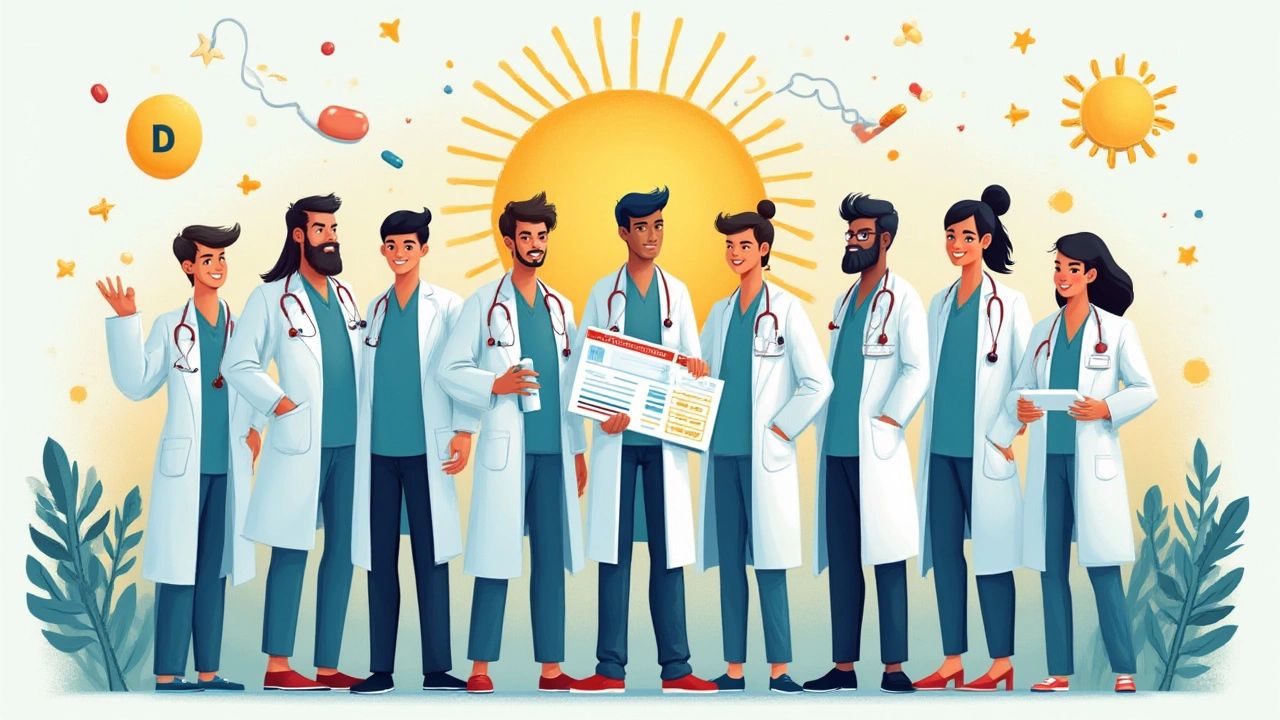
One thing keeps popping up whether you scroll Insta, browse YouTube shorts, or just overhear a chat in the gym locker room: supplements. Somebody is always saying they're popping a new capsule promising amazing energy, perfect sleep, or a miracle abs transformation. Still, when you dig into the science and peel away the hype, a single question floats to the top—if you could only pick one supplement for your health, what should it be?
The “Number One” Supplement: Why Vitamin D Tops the List
Walk into any pharmacy or health food store, and you’ll see shelves groaning with options. Collagen powders, protein shakes, greens in every shade, mystery blends with names like Thunder Elixir. The simple truth: for most people, the answer usually comes back to the humble vitamin D. Now, I know what you might be thinking—vitamin D isn't exactly sexy, right? No billboard celeb faces or dramatic before-and-after TikToks. But if you look at actual research and public health data, vitamin D is an absolute ringer.
For most adults, especially if you live north of the tropics (or, let’s be honest, spend your days indoors, hunched over laptops and phones), you’re probably low on vitamin D. In India, recent surveys show that more than 70% of people are deficient. In the US and UK, depending who you ask, it’s 30-50%, sometimes more, in winter. It’s not just about strong bones anymore. Your body needs vitamin D to help absorb calcium, sure, but it also has a hand in how your immune system fires up, how your muscles function, and even plays a role in mood. That subtle “blah” feeling during the rainy months? There’s a good chance it’s not just the weather; it could be vitamin D running low in your blood.
Some clinicians—my own doctor back when I lived in Mumbai, in fact—routinely test for vitamin D every year. If your level is below 20 ng/mL, that’s officially deficient. While you can technically get vitamin D from sunlight hitting your bare skin, modern life doesn't make that easy. Smog, sunscreen (which blocks vitamin D production), staying covered up, and a work-from-anywhere lifestyle combine to create the perfect storm for running low.
University College London ran a landmark review a couple years ago, looking at vitamin D’s effects on various body systems. Their results showed that boosting vitamin D in deficient people can truly lower the risk of respiratory infections. Harvard even published a tip sheet for clinicians, showing that supplementing with D cuts the chance of getting sick—especially important when new viruses keep making headlines.
Maybe the most interesting new info? Mental health. A big meta-analysis—this one out of the Finnish Institute for Health and Welfare—showed that folks with good vitamin D status are less likely to deal with depression and seasonal mood swings. It's not a magic fix for everyone, but when I started taking 1000 IU per day during the cloud-heavy monsoon, I really felt the difference: motivation up, afternoon yawns finally down.
Don't get me wrong, taking too much can be harmful—mega-dosing isn’t a shortcut. The sweet spot for adults is usually 600–2000 IU daily, but this depends on age, skin color, weight, and how much sun you see. I asked my wife, Anjali, what she thought, and her answer cracked me up: "I’m not risking dry hair and cranky mornings just for a stubborn attitude about supplements." I had to agree. Sometimes, the simplest fix is the best.

Surprising Facts About Supplements: Common Pitfalls and Smart Choices
If you type “best supplement” into Google, you’ll get a firehose of suggestions. Fish oil, magnesium, probiotics, iron—the list is endless and there’s always a new “must try” trending. But here’s the catch: not everyone needs every supplement. In fact, random supplementing might do nothing, or even cause trouble.
Take multivitamins, for example. The US Preventive Services Task Force issued a statement (after reviewing dozens of high-quality studies) that for most healthy adults who eat a balanced diet, daily multivitamins probably don’t make a big difference in preventing chronic disease. If you eat plenty of fruits, veggies, some whole grains, nuts, and lean protein, your bases are mostly covered—except, often, for vitamin D.
Another surprise: not all “natural” labels are honest. Supplement companies aren’t held to the same standards as pharmaceutical makers. That means two bottles of “vitamin D” or “omega-3” from different brands can have wildly different contents. In several independent analyses, bottles marked “1000 IU” of vitamin D showed anywhere from 400 IU to 1900 IU per tablet. That’s a huge swing. My tip? Pick brands that participate in third-party testing—look for the USP, NSF, or ISI marks if you’re shopping in India or the US.
There are also cross-reactions to keep in mind. Calcium can block the absorption of iron. Too much vitamin A? It’s bad news for your liver if you overdo it. Ginseng and St. John’s Wort can seriously mess with common medications for heart or mental health. A 2022 research review in the journal JAMA pointed out how surprisingly common supplement-drug interactions can be, especially in people over fifty. It's easy to get caught up in the marketing, but if you’re not sure, ask your pharmacist—they’ve seen it all.
And there’s the wallet factor. Some trending supplements come with steep price tags. Athletic greens, for instance, costs more than my grocery bill for the week. And for the average person, unless you’ve been told otherwise, there’s no strong evidence that they help you more than colorful veggies and fruits. I like broccoli, but not enough to pay ten bucks a scoop for it dried and powdered!
So, here are some quick tips if you’re looking to add vitamin D to your day:
- Check your recent blood work if you have it. Aim for 30-50 ng/mL (for most people, this is a healthy range).
- If sunlight is rare in your routine, or you cover your skin, consider a supplement (usually 600–2000 IU/day).
- Don’t combine with other big sources of vitamin A or calcium without talking to your doctor—it can affect absorption, and rarely, cause toxicity.
- Buy from reputable brands—don’t fall for “miracle” claims or knock-off bottles from sketchy online stores.
- If you’re vegan or vegetarian, double-check the source—some D3 comes from animal sources, while D2 is plant-based.
Now and then, take a break to reassess. Supplements aren’t a forever thing for everyone. After a few months, check if you’re feeling and functioning better. You might actually need to dial back or adjust the dose. Bodies shift with seasons, diets, and age.

How to Get the Most from Your Supplement: Integration with Everyday Life
People often forget that no pill, powder, or oil can make up for a wildly unhealthy lifestyle. Supplements are just that—a support to fill gaps, not a cure or replacement. I’ve seen friends put more energy into choosing the color of their capsule organizer than their actual meals. It's funny, but also a bit tragic.
With vitamin D, you get the most benefit when you make it part of a bigger routine of self-care. Start your morning with a supplement alongside breakfast, not on an empty stomach; fat helps vitamin D get absorbed. Pair it with habits you want to build—maybe a daily walk, sunlight on your face for ten minutes (even in winter, it’ll help a bit), or adding a few more dairy or plant-based calcium sources to your lunch.
A smart thing to do: keep a quick log. Note days you remember to take it, times you skip, and how your energy or mood feels. Did you feel sluggish before, but now keep up with your kids, or actually want to hit the gym after work? That’s worth noting. If nothing’s changing after a month or so (and the weather is decent for sunning), maybe you need to check your dose or talk to your doctor.
But here’s where things get interesting—people see the best results when they mix a modest supplement routine with small, consistent upgrades: regular water drinking, colorful produce, sleep that’s less "doom-scrolling" and more real rest. The synergy is real. A 2019 study from Johns Hopkins found that people who prioritized basics alongside vitamin D improved focus, lower back pain, and immunity more than those who just relied on pills alone.
Don't let habits become rituals without reason, though. Every so often, ask yourself: "Is this serving me, or is it a routine I piled on for no reason?" I’ve tried so many failed supplement routines. Collagen for my knees when I wasn’t even doing squats, green tea fat burners promising the metabolism of a marathon runner (spoiler: they mostly upped my bathroom trips, not my energy). But sticking with a simple, tested approach always did more than the trend-hopping ever did.
One last tip—notice how your body responds to changes. Some folks are "slow responders." When Anjali started taking vitamin D, she only noticed fewer colds and more energy after three months. Me, I felt less moody and less bone-crackling tired after four weeks. Your body is your best lab. And don't ignore side effects. Nausea, headaches, weird muscle soreness with high doses? Time to stop and get help. Supplements should add comfort, not confusion.
If you want to change things up or chase other health goals once your D levels are steady, work one thing in at a time: omega-3 for brain support, magnesium for muscle cramps or better sleep. But always center your plan on real food, steady routines, and realistic goals. That’s what health is about—not just a pill, but the story around it.
So, the next time those Instagram ads offer to "hack your body" with the latest supplement blend, remember: sometimes the best fix is the simplest. And for modern living, vitamin D just might be the one must-have tool in your daily kit.





Rohan Talvani
I am a manufacturing expert with over 15 years of experience in streamlining production processes and enhancing operational efficiency. My work often takes me into the technical nitty-gritty of production, but I have a keen interest in writing about medicine in India—an intersection of tradition and modern practices that captivates me. I strive to incorporate innovative approaches in everything I do, whether in my professional role or as an author. My passion for writing about health topics stems from a strong belief in knowledge sharing and its potential to bring about positive changes.
view all postsWrite a comment